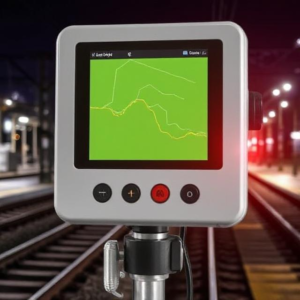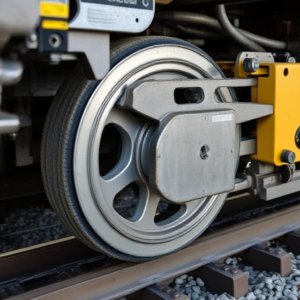What is Noise and Vibration in Railways?
- Noise refers to the sounds made by trains when they run, such as the sound of wheels on the track, the engine, and braking.
- Vibration is the shaking or movement that happens when trains move, caused by things like the wheels hitting the track or the train’s engine running.
Both noise and vibration can be a problem, especially in cities or near residential areas, because they can disturb people living nearby, affect the environment, and even damage buildings or other structures.

Why is it Important to Reduce Noise and Vibration?
- Comfort: Loud noise and shaking can be uncomfortable for passengers inside the train and for people living near the tracks.
- Health: Constant exposure to loud noise or vibrations can cause health problems like stress, sleep disturbances, and hearing damage for people living near the railway.
- Environmental Impact: High noise levels can disturb animals and disrupt local ecosystems.
- Damage to Infrastructure: Over time, excessive vibrations can cause wear and tear on nearby buildings and structures, leading to expensive repairs.
How Can Noise and Vibration Be Reduced?
1. Improving Train Design
- What is it? Modern trains are designed to be quieter and less vibrating by using special technologies and materials.
- How it works:
- Wheel and rail design: Using quieter wheels and smoother rails reduces friction, which makes the train ride smoother and quieter.
- Aerodynamic train body: A streamlined train body helps reduce the noise caused by air resistance as the train moves.
- Soundproofing the train: Adding materials inside the train, like sound-absorbing panels, can help reduce noise for passengers.
- Why it’s important? A well-designed train generates less noise and vibration, creating a more comfortable ride and reducing the impact on the surroundings.
2. Track Maintenance and Upgrades
- What is it? The condition of the tracks plays a huge role in how much noise and vibration are produced. Well-maintained tracks help reduce noise.
- How it works:
- Smooth tracks: Regular maintenance, such as grinding or replacing worn-out rails, makes sure the tracks stay smooth. This reduces the noise caused by the train’s wheels hitting rough spots on the track.
- Rubberized or quiet tracks: Some tracks are built with special materials like rubber or soft coatings that absorb sound and vibrations.
- Why it’s important? Smoother tracks lead to less noise and vibration as the train moves over them, helping reduce disturbances for people nearby.
3. Use of Noise Barriers
- What is it? Noise barriers are physical structures built along railways to block and absorb sound, stopping it from traveling to nearby areas.
- How it works: These barriers are typically made of materials that absorb sound, such as thick concrete or specially designed panels. Some barriers are even covered with plants or trees to help absorb noise more effectively.
- Why it’s important? By blocking the noise, these barriers can make the area around the railway much quieter, improving life for people living nearby.
4. Vibration Dampers and Shock Absorbers
- What is it? Special devices are used to reduce the vibrations that come from the train’s wheels and track.
- How it works:
- Track vibration dampers: These are installed on the tracks to reduce the amount of vibration that travels through the ground. They act like shock absorbers on a car, helping to minimize shaking.
- Train suspension systems: Modern trains have special suspension systems (like springs or shock absorbers) that help to absorb the vibrations inside the train, making the ride smoother.
- Why it’s important? These dampers and suspension systems help keep vibrations from disturbing passengers and nearby buildings.
5. Speed Control and Train Operation Adjustments
- What is it? Trains create more noise and vibration when they go faster, so controlling the speed in certain areas can help reduce these effects.
- How it works:
- Slower speeds in sensitive areas: In areas near homes, schools, or hospitals, trains can be instructed to travel at slower speeds to reduce noise and vibrations.
- Controlled braking: Applying the brakes in a way that is smoother and gentler can reduce the noise made by the train when it stops.
- Why it’s important? Reducing the speed of trains in noise-sensitive areas helps lower the amount of noise and vibration that’s felt by people nearby.
Technologies to Measure and Monitor Noise and Vibration:
To understand and reduce noise and vibration, technology plays an important role in measuring how much noise is being made and where it’s coming from.
- Noise monitoring systems: These sensors are placed along the tracks to track noise levels at different times of the day and night. This data helps identify problem areas where noise might need to be reduced.
- Vibration sensors: These sensors measure vibrations in the ground and nearby buildings to see how much shaking is happening. This helps engineers design solutions to reduce these vibrations.
Benefits of Reducing Noise and Vibration:
- Improved Quality of Life: Less noise and shaking means less disturbance for people living near the railways, leading to a better living environment.
- Better Passenger Comfort: Reducing noise and vibration inside the train makes for a more pleasant ride for passengers, improving their overall experience.
- Preservation of Buildings and Structures: By reducing vibrations, the risk of damage to nearby buildings or infrastructure is lowered.
- Environmental Protection: Less noise pollution can help protect local wildlife and reduce the disturbance caused to animals in the area.
Example of Noise and Vibration Reduction in Action:
In many cities, especially those with high-speed trains, noise barriers are built along the railway lines. These barriers block the loud sounds made by the trains, reducing the impact on nearby homes, schools, and hospitals. Additionally, the trains themselves might be designed with quieter wheels and smooth suspension systems to reduce both noise and vibration while traveling.
Conclusion:
Noise and Vibration Reduction in Railways is all about making train travel quieter and more comfortable for both passengers and people living near the tracks. By using better train designs, maintaining the tracks, adding noise barriers, and controlling train speed, railways can reduce the unwanted effects of noise and vibrations, making train travel more pleasant and less disruptive.
Keywords: Rail Track Systems, Railway











